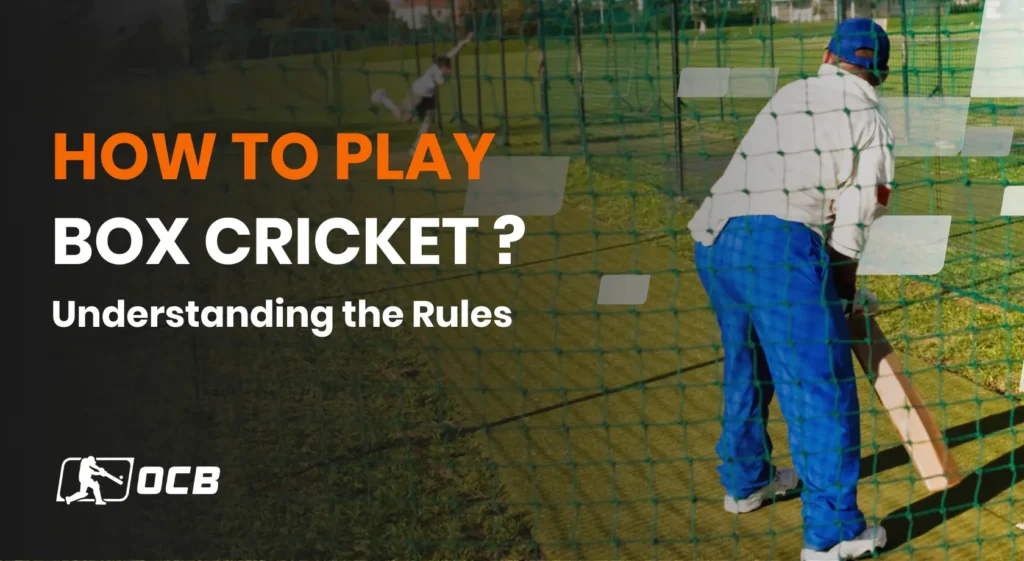Box Cricket: The Ultimate Guide to the Rules, Gameplay, and Court Dimensions
Written by: OCB Editorial Team • 12.08.2025

Cricket is a sport often associated with sprawling grounds, but in the heart of cities, an urban phenomenon has taken over: box cricket. This fast-paced, high-energy version of the game is played in enclosed courts, providing all the thrill of traditional cricket in a condensed, fast format.
Read on for the ultimate guide to box cricket rules. We'll cover everything you need to know about the game, from its origins and equipment to its unique strategies so you can learn how to play box cricket and become a pro at this popular format.
For more insights into online betting, cricket terms and rules check out our Sports Betting Guides for more information. But for now, let’s dive in.
What is Box Cricket?
| Box cricket is a small-sided adaptation of cricket played in a confined, netted area. It's a game that started in metropolitan areas like Mumbai and Ahmedabad, where a lack of large playing fields spurred cricket enthusiasts to create a new, compact cricket format. The game is accessible to all. Competitive or social matches can be played in under an hour with just a small number of players. |
The Box Cricket Boom: Rising Popularity
Over the past decade, box cricket has seen a surge in popularity, particularly in cricket-loving nations with big cities like Mumbai, Pune, Bengaluru, and Ahmedabad, where space makes traditional cricket grounds scarce. Box cricket is popular because it appeals to everyone: you don’t need a huge field, large teams, or even a full day to play. Players can enjoy the thrill of competitive cricket in just an hour or less, all within the safety of an enclosed environment.
The sport has also gained fans and popularity globally, with indoor sports facilities creating similar formats. Expat communities in the Middle East, the UK, and Australia have embraced box cricket as a social sport and it is now a staple in indoor sports complexes and urban turfs worldwide.
These are the top reasons why box cricket is so popular:
- Matches are short - Matches often finish within 30–45 minutes.
- Anyone can play – All you need is a booked court and a small group of players.
- Competition is balances – The confined space makes batting and fielding equally challenging.
Box Cricket vs Traditional Cricket: The Key Differences
While the core principles of batting, bowling, and fielding remain, box cricket changes the dynamics of the game. The enclosed space needs sharper reflexes, faster decision-making, and inventive shot-making.
Where traditional cricket rewards patience, box cricket favours aggressive stroke play and quick running between wickets. It’s also considered safer, thanks to the use of softer balls and the netted or walled enclosures that reduce the risk of injury from wayward hits.
Here are some key differences between the traditional game:
| Feature | Box Cricket | Traditional Cricket |
|---|---|---|
| Players per side | 6–8 | 11 |
| Match length | 4–6 overs per side | 20–90 overs (or more in Tests) |
| Ball type | Tennis or soft cricket ball | Leather cricket ball |
| Playing area | Netted box / enclosed space | Open cricket ground |
| Pace of play | Very fast | Variable |
Box cricket attracts players who want the fun pace of cricket without the all-day commitment. The smaller space and softer ball also reduce injuries, making it popular among corporate professionals and social cricket clubs.
Box Cricket vs Indoor Cricket: Understanding the Difference
It’s easy to confuse box cricket with indoor cricket, but there are subtle differences. Indoor cricket is usually played in purpose-built indoor arenas, often with specialised scoring zones marked on walls and floors. Box cricket, on the other hand, can be played either indoors or outdoors, as long as it’s in a confined, netted area.
The rules are often more flexible in box cricket, varying between venues and tournaments, whereas indoor cricket has more standardised international rules. Here’s some differences:
| Feature | Box Cricket | Indoor Cricket |
| Governing body | None (informal rules vary) | World Indoor Cricket Federation |
| Venue type | Rooftops, outdoor turfs, netted boxes | Specialised indoor halls |
| Court size | Flexible | Standardised (~30m × 12m) |
| Rules | Local variations common | Strict international rulebook |
While both formats are played in enclosed spaces, indoor cricket is an internationally regulated sport, whereas box cricket is community-driven and changeable.
The Origins: When Was Box Cricket Invented?
The exact origin of box cricket is tricky to pinpoint, as it developed organically in different places. In India, the sport’s roots can be traced back to urban cricket fans who began setting up makeshift enclosed pitches in big cities like Mumbai in the 1980s.
With limited space for full-size cricket grounds, players began adapting gully cricket into a structured, netted format. Corporate leagues soon picked up the idea, turning it into a popular after-work sport.
Over the decades, it spread to other areas and became a standard offering at sports complexes.

How to Play Box Cricket: The Rules and Techniques
A typical box cricket game consists of two teams competing in a set number of overs, usually six per side. The batting team tries to score as many runs as possible, while the bowling side aims to take wickets and limit the score. The smaller team size means every player is crucial, making the game more engaging and competitive.
While specific rules can vary, here’s a breakdown of the most common regulations for how to play box cricket:
- Match Format: Generally 6 overs per side, but this can range from 4 to 8 overs depending on the tournament or league.
- Team Size: A standard box cricket side consists of 6 players, with each player often contributing in both batting and bowling.
- Scoring: Runs are typically awarded for hitting the back or side nets, with specific rules for sixes. For example, a direct hit to the back net might be worth bonus points, while a ground hit could be a four.
- Dismissals: A batter can be out in several ways, including being caught out (even on a rebound from the net), bowled, or run out. LBW is rarely used, but some leagues have introduced it to make the game more challenging.
- Extras: Wides and no-balls usually add a run to the score and may result in an extra delivery, though rules can vary to keep the pace of the game high.
Advanced Rules and Variations
One of the great things about box cricket is its adaptability. Many courts have unique rules that make the game even more exciting:
- Direct Out Rule: Some formats declare a batter out if they hit the ball directly outside the net, making shot selection a strategic challenge.
- Bonus Zones: Courts often have special scoring zones on the nets, rewarding batters with extra runs for hitting specific targets.
- Retirement Rule: Batters may be required to retire upon reaching a specific score (e.g., 25 runs) to give all players a chance to bat.
Box Cricket Court Dimensions and Equipment
While there is no official standard for box cricket court dimensions, most are between 20–25 metres in length and 10–12 metres in width. The entire playing area is enclosed with nets or walls, preventing the ball from travelling out of play and keeping things fast.
The pitch length itself is shorter than a standard cricket pitch, often between 16–18 metres, making the game faster-paced. Surfaces are often covered with artificial turf to make bounce consistent and to keep players safe.
- Length: Courts are usually between 25–30 meters long, with the entire playing area enclosed by nets or walls.
- Width: The width is typically 10–12 meters.
- Pitch Length: The pitch is shorter than in traditional cricket, often around 16–18 meters, which quickens the pace of the game.
- Surfaces: The playing surface is often covered with artificial turf, providing a consistent bounce and a safer environment for players.
Box cricket equipment is minimal and designed for safety and speed:
- Ball: A soft tennis ball or a sponge cricket ball is used to reduce the risk of injury in the close quarters of the court.
- Bat: Lighter, shorter cricket bats are preferred for better control and quicker swing in a confined space.
- Optional Gear: While protective gear is not mandatory, many players choose to wear gloves, pads, and abdominal guards, especially in competitive matches.
What our experts think of box cricket
Our Cricket Analysis, Dhruv, provides his opinion into this growing cricketing format:
| Easily one of the most fun innovations that have come out in recent times! Urban areas where cricket grounds can be hard to come by are filled with cricket lovers that just want a quick game and box cricket is the perfect answer. Easy, accessible, and insanely popular around the world, it is a bite-sized version of the 'real thing' but don't tell the box cricketers that! They take it very, very seriously! |

Join our cricket betting community
Follow us on social media to stay up to date!
Box Cricket Strategy: Lessons from T20 Cricket
Playing box cricket requires a unique blend of skill and strategy. The game is often compared to T20 cricket due to its fast-paced nature. Bowlers focus on precision over raw pace, aiming for yorkers and clever angles to restrict scoring in the tight space.
Batters, on the other hand, must master the art of mixing placement with aggression, using the side nets for quick singles and timing shots into designated scoring zones.
Momentum can swing rapidly in a single over, and successful captains must constantly read the game, rotating bowlers and adjusting the field to counter the opponent's strengths. Success in box cricket needs sharp observation, quick tactical shifts, and the ability to play under pressure; skills that make the format both thrilling to play and fascinating to watch.
Final Thoughts
Box cricket has reimagined the game for the modern, urban lifestyle and a new generation of players and fans. Its fast pace, compact playing area, and strategic challenges make it a favourite among cricket lovers who want to play without committing to an entire day’s match. It’s cricket reimagined - competitive, social, and perfectly suited to modern life.
From its origins as a Mumbai street sport to a global urban phenomenon, box cricket continues to attract passionate players who value both the thrill of the game and the camaraderie it fosters. By combining the core excitement of cricket with a faster pace and smaller playing area, it offers a format that is competitive, strategic, and highly social.
Whether you’re playing for fun or in a competitive league, you can stay on top of the wider cricket world by checking out the latest cricket odds and getting our expert IPL match predictions.
FAQs
Box cricket is a fast-paced, small-sided version of cricket played in an enclosed, netted court. It was created as a popular alternative to traditional cricket in urban areas where space is limited.
No. While both are played in enclosed areas, indoor cricket has more standardised international rules, whereas box cricket rules can vary by venue.
A standard box cricket side has 6 players, though some leagues or casual games may feature 7 or 8 players per side. The smaller team size ensures that every player is an active participant in the game.
Typically 30–45 minutes for a 6-over format.
Currently, there are no major professional box cricket leagues for betting. Most betting markets focus on traditional cricket formats like Test, ODI, and T20 cricket.